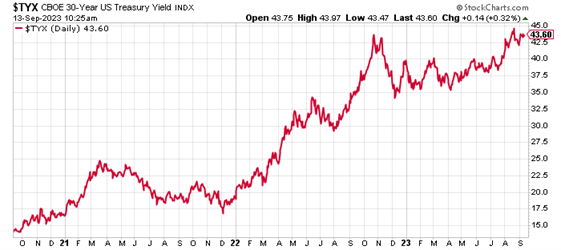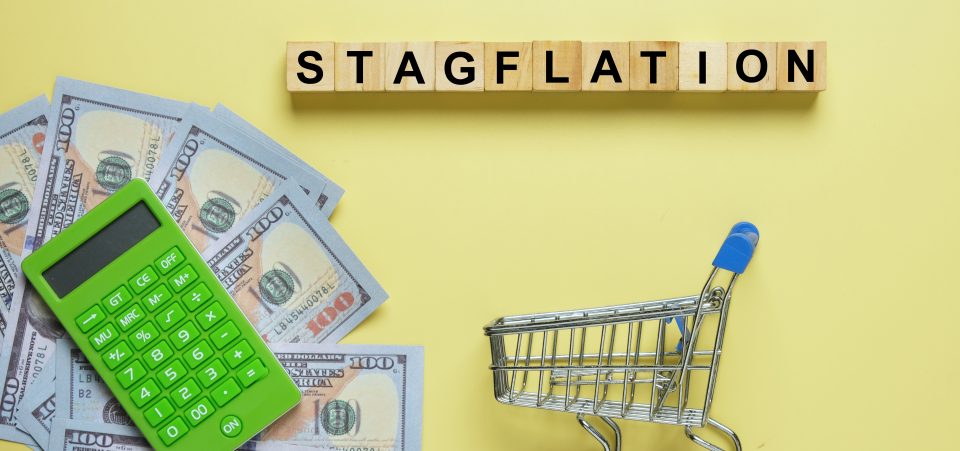Long-Term Bond Yields Are High; Stagflation Could Follow
The bond market could be saying, “something wicked this way comes,” and we might not be ready for it: stagflation. Beware: investing could become treacherous if stagflation becomes a real issue.
Stagflation occurs when the economy is weak (stagnant) and inflation is high. This hurts consumers and businesses, and it makes investing decisions difficult.
The performance of long-term bonds can be a great indicator of what’s ahead. While bond yields may tell us where interest rates will go, they can also indicate how inflation will look.
Take a look at the chart below, which plots the yield on 30-year U.S. Treasury bonds.
Over the past few years, the yield on these long-term bonds has skyrocketed. At the end of 2020, the yield on 30-year U.S. bonds was around 1.5%. Now, the yield is around 4.4%. This represents an increase of more than 190%.

Chart courtesy of StockCharts.com
Part of the reason that the yield on 30-year U.S. Treasuries has jumped is that the Federal Reserve has been busy raising interest rates. It has raised interest rates at its fastest pace in recent history, if not ever. That was because inflation was soaring in the U.S. economy.
But what’s really worth noting here is that the yield on these long-term bonds remains persistently high.
Inflation Declining for Now; Economy Showing Cracks
While bond yields have been increasing, the inflation rate has been coming down.
Take a look at the chart below. It plots the Consumer Price Index (CPI), which is the official measure of inflation in the U.S. economy. Over the past year or so, inflation in the U.S. has fallen from its multi-decade high of close to nine percent to its current rate of about 3.7%.

(Source: “Consumer Price Index for All Urban Consumers: All Items in U.S. City Average,” Federal Reserve Bank of St. Louis, last accessed September 13, 2023.)
While inflation is coming down, the U.S. economy seems to be cracking. Certainly, the headline figures suggest that nothing is wrong, but if you pay attention to the data in closer detail, it becomes very clear that the U.S. economy is heading in a very wrong direction. A recession is brewing, and it could be severe.
Average consumers in the U.S. are suffering: their sentiment is low, spending is dismal, savings are almost non-existent, and job cuts are increasing. Corporate America isn’t doing too well, either. For example, the second quarter of this year marked the third consecutive quarterly decline in the earnings of S&P 500 companies.
What Should Investors Do if There’s Stagflation?
Dear reader, keeping all of the above in mind, you might imagine that the yield on long-term bonds would be declining. This is just not happening.
Here’s the kicker: even according to the Federal Reserve’s own projections, its benchmark interest rate is expected to be lower in 2024 than it is now, and then even lower in 2025. However, the long-term bond yields remain stubborn.
All of this leads me to believe that the bond market is saying the U.S. economy is headed toward a period of stagflation. Inflation could stick around longer than previously expected, even if the economy slows down. The stagflation could be nasty, to say the least.
So, which sectors should you invest in when you see an economic slowdown approaching but inflation isn’t budging much?
Overall, stagflation could mean a lot of volatility in the financial markets. We could see massive gyrations, and in the midst of it, investors panicking. Stagflation could be extremely tough for companies’ financials, particularly those of companies in the consumer discretionary sector. So, be careful as more evidence of stagflation grows.
I think sectors like gold, health care, and consumer staples could provide some wealth preservation to investors in times of stagflation.






